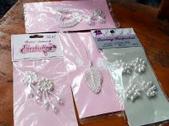Falun Gong practitioners were driven like slaves at the Masanjia Forced Labour Camp in Shenyang City, Liaoning Province, to make handcrafts such as "butterfly fairies," vines, hats, boutonnieres, hairpins and other items for export.
 |
| Exported handcrafts made by Falun Gong practitioners' forced labour in Masanjia |
From Monday through Friday, at 7:30 a.m. each day, practitioners were forced to read information and books slandering Falun Dafa. A short break happened around noon and the handiwork started at 1:00 p.m. and lasted until 8:30 p.m., sometimes extended until 10:00 p.m. There were new assignments every day and practitioners' hands were swollen from this intensive labour. Handcrafts from Masanjia's No. 2 Women's Section were manufactured under such conditions.
From April 8 to 11, 2004, an inspection group arrived to visit, but the officials at Masanjia ordered the detainees to cover up the real situation and perform singing and dancing instead. After the inspection group left, the handiwork resumed.
Every morning, 10-20 practitioners in one room were only given five minutes for washing their face and brushing their teeth. It was an extremely tight schedule.
Most of the time, practitioners were given a corn flour pancake covered with mildew and dirt, and a red soup was made from a potato slice with unhealthy-looking skin left on. In the summer, the flour and rice were covered with mildew.
In March 2003, the No. 2 Women's Section in the Masanjia Forced Labour Camp tormented and further abused the Falun Gong practitioners. Eight standard-size double beds were crammed into a single room. Because of the small space, they put four beds on top of four others, assigning four people to each bed. Practitioners were required to get up at 5:00 a.m. daily and were forced to do physical exercises after washing their faces. At 7:00 p.m. they were required to watch the evening news on TV. Except for three meals, they were forced to do physical labour every day, both morning and afternoon, for at least 12-14 hours. Sometimes they worked on crafts for export to unknown countries; other times they hand-knit sweaters for the South Korean market, and the other times they were required to work on clothing for export, such as sewing on buttons and other tasks.
During work hours, the time for using the toilet was fixed. Thirty-two people from one room took turns; they were not allowed to make contact with practitioners from the other rooms. Occasionally, when there was an urgent need for the products being made, practitioners were forced to work late, until at least 10:00 p.m. When the workload was light, practitioners were not allowed to take a rest either. Instead, they were forced to undergo brainwashing sessions, such as reading articles slandering Falun Dafa, collections of the words of Chairman Mao and stories of Lei Feng (1), or sing and dance. With regard to practitioners not yet "Reformed" (i.e. who had not renounced their belief), collaborators (2) were used to brainwash them with misleading theories the whole night. Practitioners who resisted their efforts were physically punished, such as being slapped in the face, dragged by the hair and having their head slammed against a wall and their legs pinched. Practitioners' flesh was pinched until it became lacerated; pus oozed and stuck to the clothes, and they were unable to walk due to the pain.
As to those 16 determined practitioners who refused to renounce Falun Dafa, the guards in the labour camp shocked them with electric batons until the flesh on their jaws was burned.
Notes:
1. Lei Feng: A Chinese army man in the 1960's who was widely praised for his moral consciousness, selflessness and generosity.
2. Collaborators: Former Falun Gong practitioners who have gone astray due to brainwashing and torture.
Chinese version available at http://www.minghui.org/mh/articles/2004/9/26/85009.html
* * *
You are welcome to print and circulate all articles published on Clearharmony and their content, but please quote the source.










 more ...
more ...